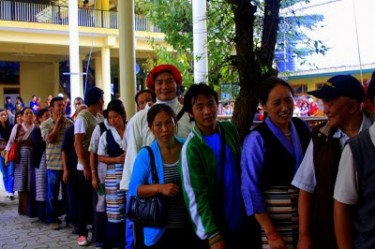Being a Tibetan in exile is a loss that manifests in many forms: the loss of homeland and natural rights fall within that. To some degree, the loss is also a blessing in disguise. Exile bestows upon Tibetan refugees in Dharamshala a reinforced national identity, a free voice, the right to practise and spread their religion without fear of persecution and the right to vote. All of these are denied to Tibetans who remain in a Han-Chinese ruled Tibet.
Chinese American academic Jianglin Li, author of 1959 Lhasa, was in Dharamshala on October 3 to observe the preliminary election of the Kalon Tripa [1], the leader of the Cabinet of the Central Tibetan Administration (CTA) [2], a pressure group subordinate to the 14th Dalai Lama. The CTA's stated goal is to “rehabilitate Tibetan refugees and restore freedom and happiness in Tibet”. The CTA is commonly known as the Tibetan government-in-exile [3].
As Li described in her photographic journal of the election, [4] voters turned out in droves at local polling stations. It is impossible to ignore the smiles on their faces.
The process of electing the Kalon Tripa (Chairman of the Kashag or Cabinet) is similar to a popular vote for the head of state in western democracy. Alongside it was the election of the senate, however, with a Tibetan twist. Li explained the election rule:
议员共40名,西藏三区各10名,四大教派加苯教各两名,加起来就是40名。僧人可以投两票,一票投给他所在的地域,另一票投给他所属的教派。比方说,一个来自康区的黄教僧人,他可以投一票给代表康区的议员,还可以投一票给代表格鲁派的议员。
According to the Election Commission 79,449 people registered to vote. In the last general elections in 2006, 72,771 people registered to vote, but the number that actually voted remained less than 50 percent of those registered. The official figure of the Tibetan exile population is about 150,000. (via Tibet Sun [6])
It is hard to imagine that when the 14th Dalai Lama first arrived in India in 1959, via the treacherous Himalayan path, only a small number of people accompanied him. In the years that immediately followed, over 20,000 Tibetans followed the same route to exile. Attempts to pass through what is now the Chinese border have never ceased, seemingly undeterred by frequent fatalities. A YouTube video taken by a group of western mountaineers and circulated widely online, shows Chinese border guards opening fire on a group of unarmed Tibetan civilians in 2006 [7], as the latter attempt to cross the border. Many of the Tibetans are young and scarcely equipped for the journey.
Li related her own experience with the Tibetan in exile:
目前,作为藏人,想要行使你的民主权利,你先得流亡,让你的身份成为“流亡藏人”。不过,其实我自己也一样,我的民主权利来自美国,而非中国。我行使自己的民主权利,先得让自己变成“美籍华人”。。。
Li's remark certainly resonates among the Tibetan activists. Prominent Tibetan poet and writer Woeser, who lives under constant surveillance in her Beijing home and has been banned from leaving China, linked to Li's journal on her blog, the Invisible Tibet (post deleted see cache [8]). She relates to Li's observation about the “lucky” refugees:
而在我的人生中,我从未有过自己做主参与投票选举的经历……
The election in India was quite smooth. However, in Nepal, the process had been disrupted by local officials. Tibet report [9] writes:
…the instability that has been the highlight of the Nepalese Government has provided the Chinese Government with willing officials there who play into their hands to deny basic and fundamental rights to Tibetan refugees in Nepal. On October 3 we witnessed on such attempts when local officials seized ballot boxes from the Tibetan community in Nepal’s capital, who were participating in this worldwide elections.
Apart from South Asia, the election also took place in Europe and North America among Tibetan exiles. Chopathar described the election scene in New York in the comment section of Woeser's post (see the cache link above):
纽约的投票现场非常热烈壮观,人进人出,因为大堂里人太多,一部分投完票的人必须得出来。投票地点在曼哈顿。
我很早就去了,我排队排到了第一位,当然是第一个签名和领到选票及投票的。为自己苦难的祖国图伯特尽一份心,我感到无上光荣。
Chopathar 10.04.2010 纽约市
The final elections to decide the composition of the Kalon Tripa will be held on 20 March 2011. Thubten Samdup, the Dalai Lama’s representative in Northern Europe, created a website [10] to attract more candidates. From the questions which have been posted for the future candidates, readers can get a sense of the most critical preoccupations of Tibetans-in-exile:
What is your position on the China Tibet negotiations and what would you do differently?
What measures do you believe we, the Tibetan community in exile, can take to effect positive changes in the lives of Tibetans residing inside Tibet; especially those confronting land rights issues, unwarranted detentions, and inequalities in competing for education and jobs?
What would you do to revitalize our large Tibetan settlement camps and reverse the current trend of many young Tibetans leaving their communities in order to find employment elsewhere?
What would you do to improve the standard of education in our school system and how would you help young Tibetans preserve their culture while in exile?
